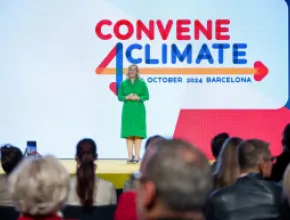In a survey my company, MeetGreen, took last month, results showed that 44 percent of respondents planned green events but do not yet measure them. Now, if you have gone to all the work to recycle, conserve, reuse, divert, minimize and monitor, it is time to reap the benefits. Because if you are going to invest the time and energy to implement sustainable practices, why not track those initiatives? Capture the data and put it to work.
Following are some real-life experiences from our colleagues describing what data can do for you.
Data can:
- Make the CEO look good when he stands in front of an audience the first day of the annual meeting and reports, "by minimizing our conference brochure we saved 987 trees."
- Thrill the CFO when you say your green initiatives saved the company $151,000 on the last annual meeting.
- Impress the corporate social responsibility director when you provide metrics showing your organization is an excellent corporate citizen doing everything possible to minimize your impact, including a 76 percent landfill diversion rate during the event. Not to mention the important donation of food and volunteers to a local homeless shelter while hosting a conference in a major city. Think of how this plays into the bigger picture of CSR reporting for them.
- Enroll a sponsor when they proudly pose for a photo opportunity for the media reporting the importance of underwriting the 100 percent renewable energy program at the venue, saving enough energy to power 1,200 homes for a year.
- Cheer up the travel department when you review the carbon footprint of your conference delegates and (because of the numbers in black and white) decide to hold it in the closet city to the majority of delegates—saving many thousands of dollars, time for the travel department and getting the participant’s butts out of airplane seats faster.
- Motivate the employees when they learn their organization has earned two important environmental awards based on measuring and tracking environmental considerations.
Here’s How to Do It
Numbers are powerful and can increase your leadership role within the organization. They allow you to work outside of your traditional role as a meeting professional and coordinate with other organization thought-leaders.
You become an incredibly valuable asset on many levels. Your idea to link the event’s key performance indicators with those already being collected on other initiatives within your business will make an impression not soon forgotten.
Now you know why to track the numbers, here’s how to track them in a few simple steps.
- Choose a few key performance indicators (KPIs) to track for every event or meeting. Start with five or less just to make it easy and build from there. Choose indicators that are easy to replicate in different locations or venues. For instance, the percentage of waste diverted from a landfill at the meeting site or percentage of post-consumer recycled material used in all show publications or amount of signage reused from a previous meeting.
- Start early and set up the systems required to capture the information. In the first example of measuring waste diversion, make sure the venue and hauler know you will require this information within 30 days of the event (put it in the contract).
- Collect the data. Again, this is much easier if you have alerted everyone.
- Analyze the data and let all your stakeholders know what you were able to achieve. Tell your story. Whenever possible, tell it in trees saved, automobiles kept off the road, homes you could power. Humans respond quicker to a visual image than to the raw numbers; that’s why the real-life examples are so powerful.
This information will also give you a benchmark to build from in subsequent events or years. It is easy to get overwhelmed when working with KPIs, so start simple and use indicators that reflect both an environmental and economic savings for early success. Later you can become as complex as the time and resources allow. Our industry is also becoming more sophisticated, with a variety of calculators and reporting systems available now to help.
It is said, "If you can’t measure it, you can’t manage it." We believe the benefits of measurement go far beyond just management, to the telling of the story and the ability to engage others in the vital work of sustainable meetings and events.
Nancy J. Wilson, CMP, is a leader, innovator and entrepreneur in the meeting planning and events industry. She began her career in the industry in 1978 and is now a principal with MeetGreen, a Portland, Ore.-based conference management and consulting firm that she founded and which specializes in green meetings. Wilson served on the Live Earth Global Green Team and is cofounder of the Green Meeting Industry Council. Wilson is also the coauthor of Simple Steps to Green Meetings and Events. Her blog, "Pretentious Musings of a Meet Green Martyr," shares resources, tips, ideas and funny stories about the life of a green meeting planner, and can be accessed at http://blog.meetgreen.com. To enquire about purchasing a checklist and other tools for planning a green meeting, contact MeetGreen at info@meetgreen.com.






